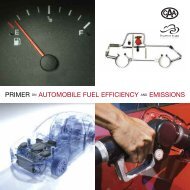Primer on Bioproducts - BIOCAP Canada
Primer on Bioproducts - BIOCAP Canada
Primer on Bioproducts - BIOCAP Canada
You also want an ePaper? Increase the reach of your titles
YUMPU automatically turns print PDFs into web optimized ePapers that Google loves.
commitments of the United Nati<strong>on</strong>sFramework C<strong>on</strong>venti<strong>on</strong> <strong>on</strong> ClimateChange to include targets for futuregreenhouse gas (GHG) emissi<strong>on</strong>s bydeveloped countries. <strong>Canada</strong>’scommitment under the Kyoto Protocolis to reduce net GHG emissi<strong>on</strong>s to sixper cent below 1990 levels between2008 and 2012. The protocol wasdeveloped in 1997 in Kyoto, Japan.Landfill: Land where householdwaste, industrial waste and/or treateddomestic sewage biosolids aredisposed.Landfill gases: Gases generated bydecompositi<strong>on</strong> of organic material atlandfill disposal sites. Landfill gas isapproximately 50–60 per centmethane, 40–50 per cent CO 2, and lessthan <strong>on</strong>e per cent hydrogen, oxygen,nitrogen and other trace gases.Megawatt (MW): An electrical unit ofpower that equals <strong>on</strong>e milli<strong>on</strong> Watts(1,000 kW).Micro-organism: Any organism thatcan be seen <strong>on</strong>ly with the aid of amicroscope.Nanotechnology: Atomic- ormolecular-scale technology developedat dimensi<strong>on</strong>s of less than 10milli<strong>on</strong>ths of a metre (100 nanometres).Organic: Derived from livingorganisms, c<strong>on</strong>taining naturallyoccurring carb<strong>on</strong> (and hydrogen)compounds.Petrochemicals: Chemicals derivedfrom oil, natural gas or otherfossilized hydrocarb<strong>on</strong>s.Photosynthesis: The c<strong>on</strong>versi<strong>on</strong> byplants of light energy into chemicalenergy (carbohydrates are made fromCO 2and water in the presence ofchlorophyll and sunlight). Thechemical energy is then used tosupport the biological processes of theplants and animals that eat them.Protein: An organic moleculecomposed of amino acids that areresp<strong>on</strong>sible for cell maintenance andgrowth.Pyrolysis: The thermal decompositi<strong>on</strong>of biomass at high temperatures(greater than 200°C) in the absence ofair. The end product of pyrolysis is amixture of solids (char), liquids(oxygenated oils), and gases (methane,carb<strong>on</strong> m<strong>on</strong>oxide, and CO 2), withproporti<strong>on</strong>s determined by operatingtemperature, pressure, oxygenc<strong>on</strong>tent and other c<strong>on</strong>diti<strong>on</strong>s.Sequestrati<strong>on</strong>, sequestered: Thel<strong>on</strong>g-term storage of carb<strong>on</strong> in theterrestrial biosphere, underground, orin the oceans, isolating the carb<strong>on</strong>from the carb<strong>on</strong> cycle to ensure thebuild up of CO 2(the principalgreenhouse gas) in the atmospherewill be reduced.Sustainable development: Accordingto the 1987 UN World Commissi<strong>on</strong> <strong>on</strong>the Envir<strong>on</strong>ment and Development,“development that meets the needs ofthe present without compromising theability of future generati<strong>on</strong>s to meettheir own needs.”Syngas: A “synthesis gas” c<strong>on</strong>sistingmainly of carb<strong>on</strong> m<strong>on</strong>oxide (CO) andhydrogen (H) that is created by thegasificati<strong>on</strong> of liquid or solid biomass.Syngas is used for producing poweror hydrogen, methane and otherfuels.Thermal depolymerizati<strong>on</strong>: Aprocess that uses pressure and heat toreduce biomass (usually organicwaste material) into light crude oil bybreaking down l<strong>on</strong>g-chain polymersof hydrogen, oxygen and carb<strong>on</strong> intoshort-chain petroleum hydrocarb<strong>on</strong>s.The process, also calledthermochemical c<strong>on</strong>versi<strong>on</strong> or athermal c<strong>on</strong>versi<strong>on</strong> process, is thoughtto mirror the natural geologicalprocess that produces fossil fuels.Thermochemical processing: Thechemical processing of biomass athigh temperatures to produce fuels,such as biogas or bio-oil. Pyrolysisand gasificati<strong>on</strong> are examples ofthermochemical processes.Thermo-chemistry: The branch ofchemistry that explores theinteracti<strong>on</strong> of heat and chemicalreacti<strong>on</strong>s.Toxic substance: A chemical ormaterial harmful to people, plantsand animals.Turbine: A machine of rotary bladesand a drive shaft that uses the energyof a stream of fluid (usually water orsteam) to power a generator thatcreates an electromagnetic field,transforming the mechanical energyinto electricity.Yeast: A general term for single-celledfungi that reproduce by budding.Some yeasts can fermentcarbohydrates (starches and sugars).PRIMER ON BIOPRODUCTS69
















